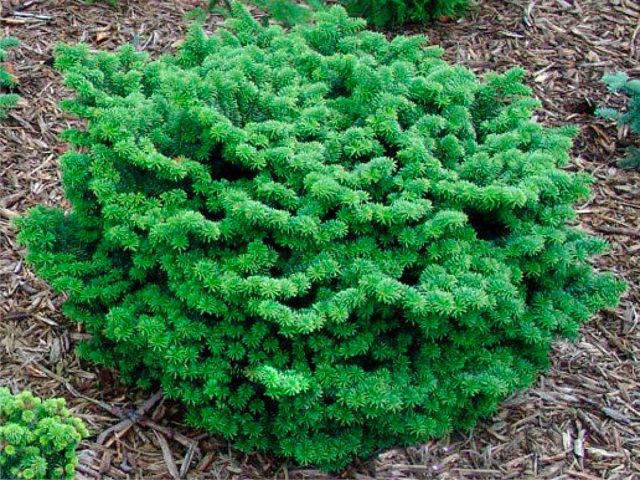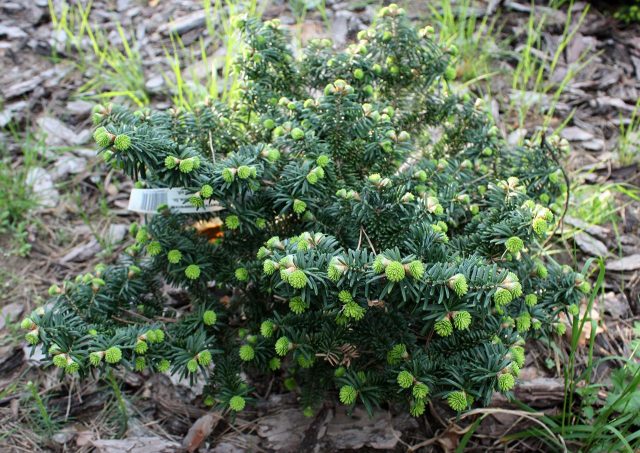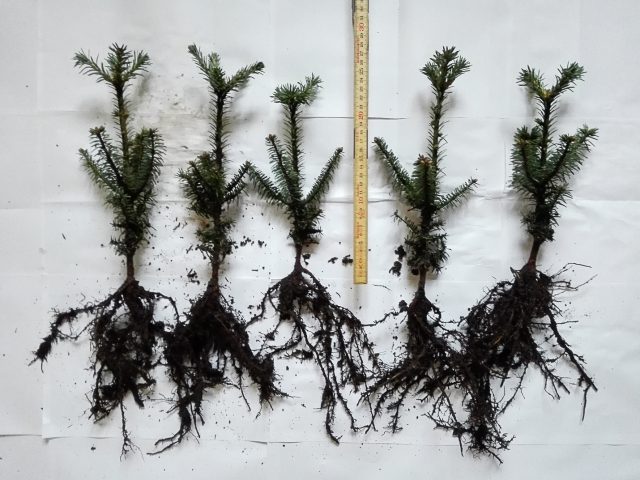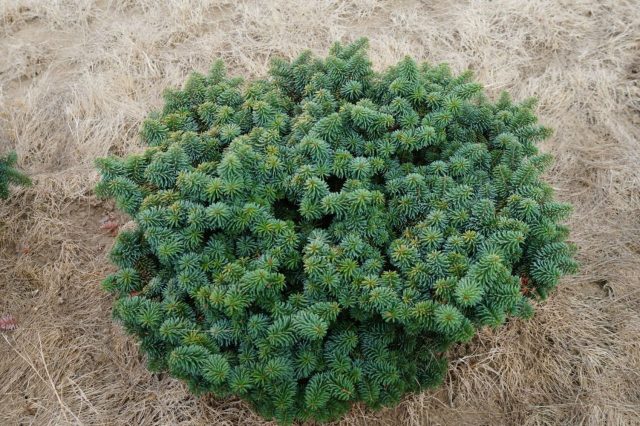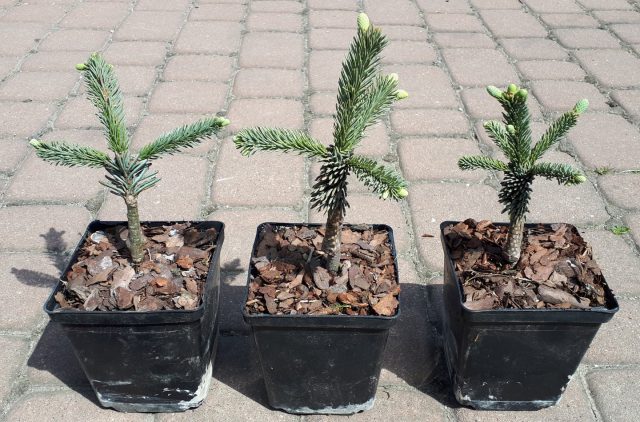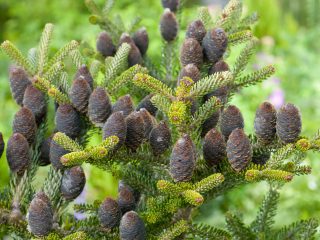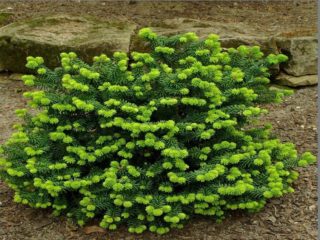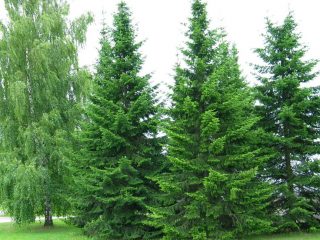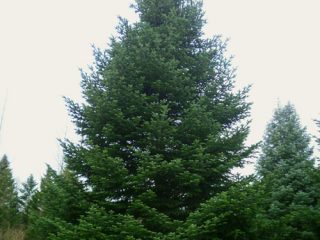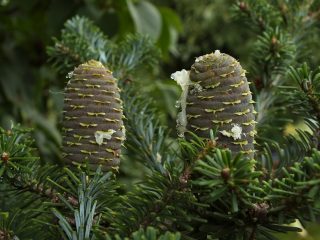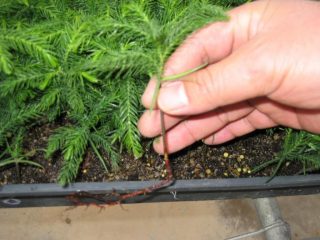Content
The personal plot is a kind of artist's canvas. What the landscape will look like depends on the owners and designers. Why not try to recreate themed corners dedicated to different plants. Since ancient times, fir has had a beneficial effect on people. The ancient Greeks considered this plant sacred, identifying it with the goddess Hecate. Today, balsamic fir Nana is widely used in aromatherapy. By planting such a plant on the site, you can get your own corner of relaxation. And in winter, it will turn into a fabulous area, enveloped in an atmosphere of magic and celebration.
Description of balsamic fir Nana
Balsam fir Nana comes from the Pine family. These are small trees about 1 m high. The crown can be cushion-shaped or have a geometrically regular conical shape. Balsamic fir branches are rather spreading, decorated with dense needles. It is short - only 4-10 mm long and no more than 1 mm wide. Glossy, with a rich green tint in adults and a delicate light green in young ones. The middle and edges of the needles also have a light shade, and the bottom they are decorated with a white stripe with a bluish tint.
When growing, it is necessary to take into account the peculiarities of the surface root system of balsamic fir Nana. It also has other features. For example, all resin passages are concentrated in a smooth bark. In other conifers, they are located in the wood. Conical cones are highly decorative. Their colors range from pure brown to various admixtures of violet.
Balsam fir Nana in landscape design
Looks original as a hedge. Balsam fir Nana is harmoniously combined with various trees and herbs. Will be a real decoration for the alleys. The neighborhood of pine needles with an artificial pond will be quite interesting.
Planting and caring for Nana fir
Growing Nana fir does not require any special skills. It is enough to create comfortable conditions, and the tree will delight with its beautiful appearance.
Seedling and planting plot preparation
The choice must be approached carefully. The finest Nana balsam fir seedlings can be found in nurseries or specialty stores. Additionally, you can consult with the staff. You should not buy seedlings younger than four years old. In appearance, the trees should be healthy, with even, smooth bark without injuries and dried shoots. Pay attention to the soil in the container. With proper plant care, it will be clean and moderately moist.
The most optimal time for planting in the ground is spring. It is necessary to select a shaded area in advance. An additional plus will be the proximity of the reservoir. But planting Nana fir near the road is a bad idea. She does not tolerate gases and dry air.
The soil must be prepared in advance:
- It should be cleaned of weeds and dig up. Nana Balsam Fir prefers soft loamy soils.
- About two weeks before planting, a pit is prepared.
- Next, two buckets of water are poured into it. The moisture should be completely absorbed into the soil.
- After that, another digging is carried out (approximately for a shovel bayonet).
- Drainage is placed on top: brick fragments and fine crushed stone.
- Now it's the substrate's turn. It is best to cook it yourself from clay and humus with sand. Also add about 10 kg of sawdust, a little peat and nitrophoska (200-300 g). Mix everything thoroughly.
- The planting hole is filled approximately halfway with the resulting mixture.
So the soil will stand for the next 14-15 days. It should shrink.
Landing rules
A small mound is made of the ground. A balsam fir seedling is placed on it. The roots must be spread carefully. The level of the root collar should match the level of the upper edge of the pit. Nana fir seedling is sprinkled with earth and slightly compacted. Now the plant needs to be watered abundantly.
2.5 m of free space is left between the trees. If they land in the alleys, then at least 5 m.
Watering and feeding
You cannot overdo it with moistening the earth. But desert conditions are not suitable either. Two or three waterings are done throughout the spring. For this, only settled water is used. After the soil is weeded and loosened. Sprinkling of the crown is used in the summer.
Balsam fir Nana loves a fertile environment. As soon as two years have passed after planting, it is time to fertilize. The procedure is carried out every spring. Top dressing is applied to the tree trunk circle (100 g of Kemira for each specimen). You can additionally support balsamic fir in the fall. During this period, mineral complexes are used.
Mulching and loosening
Heavy soil with a dry crust can kill balsam fir. For the roots to breathe and get enough moisture, loosening is required. Considering that the root system is superficial, no deeper than 10-12 cm. Along the way, it is necessary to get rid of weeds.
Mulching is usually carried out after planting Nana fir (moisture preservation) and in the fall (plant warming). The best raw materials are bark, wood chips and sawdust. The maximum layer does not exceed 10 cm. For young bushes, a 5 cm layer of mulch is enough. Do not cover the root collar of balsamic fir.
Pruning
Carried out only as needed. Fir Nana does not tolerate excessive manipulation of the crown. Sanitary pruning is done before the juice starts moving. Dry and damaged branches of Nana fir are removed only with special garden shears. Before the procedure, at least 10 years must elapse from the date of planting. Sometimes shoots of balsamic fir Nana are pruned more often, but not more than a third of their length.
Preparing for winter
As a typical representative of conifers, balsam fir Nana calmly tolerates frosts. Young bushes are additionally insulated with spruce branches. The trunks are covered with a layer of peat. On top of the fir, Nana can be covered with special cloth covers. They will not only protect the plants, but also become an additional decoration of the site.
Reproduction
Several breeding options for Nana fir are possible.
Cuttings. They are harvested at the very beginning of spring, until intensive sap flow has begun. Nana starts cutting balsamic fir in the morning or in the evening. The optimal cutting length is from 5 to 7 cm. Only young plants with annual shoots can be a source of planting material. One bud is left at the top of the cutting. The so-called heel cuttings take root most quickly. They are not cut off, but abruptly torn off. A piece of bark remains at the disconnection site. It is deburred. After the finished cutting is disinfected in a pale solution of potassium permanganate (several hours are enough). Now you need to choose a pot or box that is suitable for the size. A soil mixture of humus with leafy earth and sand is poured into it. Cuttings are placed in the finished substrate and sealed with foil. It is advisable to heat the containers from below.
In order for the cuttings to take root successfully, you need to provide them with a temperature a couple of degrees higher than room temperature. You will also need intense sunlight, regular ventilation and moisture. The first roots will go only by the second year. Balsam fir Nana has a slow growth rate.
Seeds. Choose a slightly immature bud. It dries up naturally for a while. Then the seeds are removed. They need to undergo cold hardening. The seeds are laid out on a piece of damp cloth and folded gently. Then they put it in a container with sand and send it to the refrigerator. They will spend several months there. In April, it's time to sow seeds. This can be done directly in open ground. You will need a separate bed with sod-sandy soil. The seeds are buried by 2 cm. It is not worth moistening. Instead, the plantings are covered with foil. In about a month, the first shoots will delight.
Diseases and pests
Nana balsam fir is resistant to various diseases. Only inappropriate climatic conditions can weaken her immunity.
In this case, you can face the following diseases:
- Spruce-fir hermes. The needles begin to turn yellow, small white lumps appear. They are like cotton wool fibers. You can fight them with systemic insecticides.
- Needle rust. Fungal disease common in spring or summer. Young animals are most affected.
Among the pests, the following specimens can be observed:
- Pine cone moth. Caterpillars emerge from the larvae, which gnaw through the cones and eat the seeds. The plant is treated with insecticides.
- Click beetles destroy the root system of Nana balsamic fir. You should be especially careful in May.
- Bark beetles only weakened bushes are affected. Sometimes these pests appear on the site along with low-quality fir seedlings.
Conclusion
Balsam fir Nana is rightfully considered the queen among conifers. Caring for her will not bring much trouble. Its rich in nutrients oils will help to relax, have a beneficial effect on the heart and blood vessels. Having planted a fir on the site, you can acquire not only an unusually beautiful shrub, but also a home doctor.
